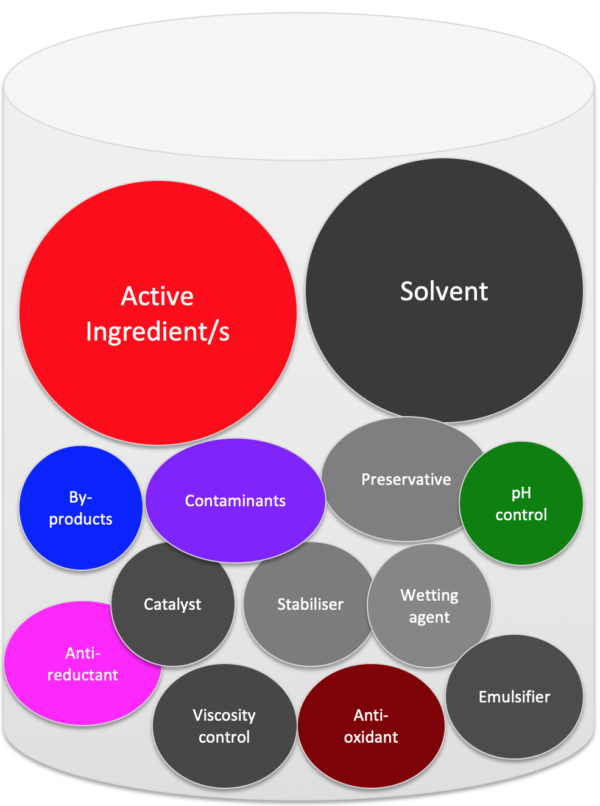In the apparel industry, prior to the introduction of manufacturing restricted substance lists (MRSL’s), brands used restricted substance lists (RSL’s) to manage hazardous chemicals.
RSL’s restrict certain chemicals on finished products, whereas MRSL’s include all chemicals used at a facility. Other differences between the two types of lists can be found here. This approach, although effective, does not provide visibility into all of the chemical substances present in a chemical formulation.
This is the second blog in my chemical management series. The first, which discusses two chemical management trends in the apparel industry, can be found here.
To understand full chemical disclosure, we must define a chemical formulation, because chemical formulations are used to manufacture textiles rather than individual chemical substances.
What is a chemical formulation?
Here is a visual representation of a chemical formulation. The individual ingredients, with their function, are shown in colored bubbles, although not to scale!
 Chemical formulations are mixtures of individual chemical substances, which all have a specific function in the formulation. These include solvents, preservatives, buffers, active ingredients, just to name a few.
Chemical formulations are mixtures of individual chemical substances, which all have a specific function in the formulation. These include solvents, preservatives, buffers, active ingredients, just to name a few.
Some of these substances are hazardous, some may be present as impurities, and some may be unreacted monomers or residuals, often at very low concentrations.
Safety data sheets (SDS’s) communicate the hazards associated with a chemical. Chemical suppliers, who author SDS’s, only have to disclose REGULATED chemical substances if they are present above a certain amount, between 0.01% to 1% of the total concentration, depending on the type of chemical.
This means
- that hazardous chemicals may be present in a formulation at very low concentrations
- LIMITED visibility into the ingredients in a formulation
Due to the enormous number of textile items produced annually, the amount of hazardous chemicals soon adds up and causes harm to people and the planet.
Why full chemical disclosure matters
Clean Production Action, an NGO that develops chemical management tools and strategies to advance safer chemistry authored a paper on the business case for knowing chemicals in products and supply chains and identified risk reduction as the key reason why it matters.
In addition to risk reduction, full chemical disclosure provides a host of additional advantages. These include:
- Allows brands and others to make informed decisions about chemicals. This includes which chemicals to use, which ones to prioritize for phase-out, and which ones not to use.
- Enable a company to proactively develop and implement chemical management strategies and action plans. The result may enhance brand reputation.
- Allows companies to stay ahead of chemical regulations. For example, a brand may be unaware that a regulated chemical may have been used or present in a formulation.
- Reduces greenwashing and provides more data to substantiate chemical-related claims or relevant consumer-related claims.
- Promotes and accelerates green chemistry. The safest chemical, or the chemical with the most appropriate hazard-profile for its intended use, can be identified.
- Will be necessary to support the recyclability of materials. Hazardous chemicals that may be present in materials designed for recyclability prevent safe recycling.
In the past few years, the apparel industry has been progressing towards full chemical disclosure, and that is the topic for the next blog article in the series.
Do you need help with chemical management?
For help with sustainability, circularity and chemicals, contact Amanda Cattermole at (415) 412 8406 or Amanda@cattermoleconsulting.com. We can help you develop powerful solutions to protect your company and brand reputation.
Tips and Insights contains information to help you make informed sustainability decisions. Each post highlights a particular topic and includes questions you may want to consider for your business.

